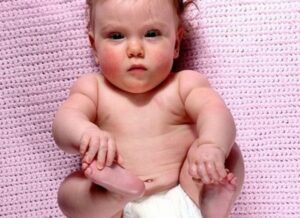Vegan Pregnancy Part Eleven: Cloth Diapers or Disposable?

With less than a month to go until my due date, it’s hard to believe this pregnancy is winding to a close. I’ve traded in vegan diet and age-related concerns for those that will affect us after my daughter arrives. This week’s conundrum: cloth diapers or disposables?
At first thought, disposable diapers seem like both the best and the worst option in one: they’re convenient, which I suspect will be a super high priority for me. But they’re also extremely wasteful, filling up our landfills with toxic human waste. That’s kind of depressing. I don’t want my daughter to inherit a messy world her own poop helped make worse. How can a diaper be both so appealing and repelling at the same time?
According to the website Diaper Free Baby (we’ll talk about diaperless babies shortly), 95 percent of American babies wear disposable diapers, sending more than 3.5 million tons of them to landfills every year—roughly 2 percent of all garbage made in the country! On average, a baby will go through 5,000 to 8,000 diapers before potty training sticks. And those diapers come at another cost besides the waste: a quarter of a million trees each year are killed to make disposable diapers in the U.S.
Still, there are eco options in the disposable category. For example, gDiapers claims that their disposable inserts are “100% biodegradable (wet ones only) in a home compost in 70–150 days per a third party independent testing facility.” But biodegradable diapers can’t break down in airtight landfills, reports Wired. And that’s not even taking into consideration what happens when feces from those supposedly bio diapers does eventually leak into waterways.
But are cloth diapers any better? Cotton is one of the most pesticide-intensive crops on the planet. So, unless you’re using organic cotton diapers, your baby’s bottom is supporting a chemical cocktail nightmare that’s extremely damaging to the environment. Not exactly eco-friendly. Plus, the production of cotton cloth diapers requires excessive amounts of fresh water (as do disposables). And that’s not even taking into consideration the water used in washing the diapers—whether you do this at home or via a diaper service.
According to Wired, there’s really no clear winner when it comes to diapers. Both cloth and disposable have benefits as well as drawbacks. So, with that being the case, I’m leaning towards the comfort factor for my daughter. Living in Los Angeles, we have organic diaper delivery service options, which seem like the best option. Washing in bulk reduces the water I’d use in my home washing machine. While there is still the issue of fossil fuels used in transport the diapers to and from their warehouse, it’s less than the gazillion trips we’d make to the store for disposables. And all reports I’ve heard from other mothers is that cloth causes fewer cases of diaper rash, even if you have to change them more often. Sensitive skin runs in both my family and my daughter’s daddy’s family, so, we like the idea of avoiding any discomfort for her if we can.
There’s a bonus to the frequent diaper change necessary with cloth diapers I’m told as well. Because disposable diapers are so much more absorbent (because of the unnatural gel packs), the baby is less likely to feel as wet, and that means it can also be more difficult to potty train. But cloth diapers don’t absorb as much. Meaning, the baby feels wet sooner and that helps them to communicate the need to be changed more frequently.
Which brings me to the most appealing diapering method of all: no diapers. Elimination communication is a technique of reading certain signals in your undiapered child and getting them over the toilet just in time. According to Diaper Free Baby, “Practicing Elimination Communication allows families to avoid struggles sometimes associated with diaper changes and toilet training. Elimination Communication can also account for and reduce some “unexplained” fussiness in infants, and eliminate diaper rash.” While it’s not recommended for the super newborn infant, it can be done fairly early on in a child’s life and reduce the potty training time significantly. It’s a concept that’s certainly piqued my curiosity, so I’ll report back if and when we give it a try. Until then, I’ve still got labor and delivery to get through first.
This is the latest installment of the series, Vegan Pregnancy. Read the entire series:
Keep in touch with Jill on Twitter @jillettinger
Image: eBomb716

